 |
|
|
| , | ||||
|
A Walk on the Wild Side by Michael Marcotte
Sam calls the boots "Welties," which I surmise is short for Wellington Rubber Galoshes. Sam likes nicknames, I guess. She is really Samantha. Maybe it has something to do with talking as little as possible in the jungle...(The Madre de Dios is really a rain forest, but "jungle" takes fewer syllables and conjures better imagery). 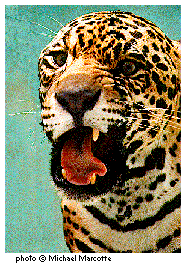
Sam is in the third month of her six-month stint as a resident naturalist at the Explorer's Inn, a jungle lodge nestled far from the maddening crowds of any semblance of civilization. She's back at the compound. I am...alone in the jungle. It takes me about forty-five seconds to extract one foot and take another step. When the boot does come free, it slides halfway off my foot and an obscene sucking slurp echoes like a gunshot through the woods around me. Great. I'll have to sit still for a half-hour or more before any wildlife comes within a quarter-mile of my vantage point. It's two o'clock in the afternoon, but the canopy formed by the towering trees allows so little sunlight to permeate to the ground below that it might just as easily be twilight. 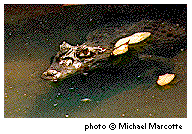
It occurs to me, as the mud struggles valiantly to retain my other foot, that if a remotely curious jaguar were to happen by, I would seem to be a wondrously convenient mid-day snack. There are jaguars around, in fact. A fresh paw print was found right at the edge of the compound, only this morning. That's hardly surprising. The Explorer's Inn is four hours from Puerto Maldonado - the closest city. Hundreds of square miles of virgin rain forest lies in every direction, as yet untrampled by civilization's encroachment. There are no roads into this part of the Madre de Dios. The infrequent human trespassers arrive, as did I, by motorized piroque. The majority of humans in this jungle are Indians - Huarayos, Yagua and others, who live in large family groups or small villages. A handful of other jungle lodges are scattered around the Tambopata, Manu and Madre de Dios rivers that provide the only access into the more remote recesses of the rain forest. 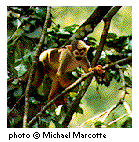
I am out on the trail, by myself, for a reason. I have followed Sam and my fellow jungle visitors on three other extended jaunts, but I have come to the conclusion that we humans talk too much. If you want to see animals you have to BE QUIET. In about an hour and a half, I wind up sighting far more birds, monkeys and scurrying denizens of dubious origin than in the entire previous two days with the group. I find a lot of tracks: peccary, deer, jaguarundi, but no jaguar or puma. Parrots, toucans, and forest turkeys make frequent and raucous appearances, while families of howler monkeys hoot loudly nearby, rustle the branches high overhead or allow one or two fleet glimpses. Leaf-cutter ants form impressive columns as they transport their harvest to-and-fro, and capybara or other large rodents occasionally dart across my path, but I never get to see an anteater, tapir or larger animal. Still, just knowing that they're there adds a thrill to this little nature trek. 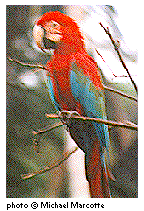
The Explorer's Inn is located on the banks of the Tambopata River, within the restricted Tambopata-Candamo Reserve of the Peru's Madre de Dios. The reserve covers over 1.5 million hectares of rain forest. That's almost a third the size of Costa Rica! The sparsely populated Madre de Dios is part of the largest continuous expanse of rain forest in the world. Much of this jungle is so impenetrable that it has never been explored. In the rivers, tributaries and abundant lagoons dwell several species of South American crocodile, piranha and anaconda. Underfoot and through the branches slither the bushmaster, fer-de-lance, coral snake and many of the world's other deadliest snakes. There are still Indians living deep in these jungles that have yet had little or no contact with the outside world. Some of them use poison-dart blowguns. This is my kind of place. Who else comes to such a remote and rugged location? And why? Certainly not those of you who need to ask. Adventure travel enthusiasts come from all walks of life. They might be accountants or they might be teamsters, secretaries or flight attendants. What they have in common is more than a love for nature and the outdoors; it is more like a strong and intrepid compulsion to peek over the edge of civilization. Having done so, it then becomes an ongoing fixation to step across into those few frontiers that remain on this planet. I can't explain it. Admittedly, it is my favorite thing in life to get away from the rest of you for brief respites, but that's only a part of it. It is the "walk on the wild side" - the possibility of danger that adds a measure of irresistibility that is puzzling, yet essential to all the best journeys. There are five or six rustic bungalows back at the Explorer's Inn compound. They have thatched roofs and no air conditioning or ceiling fans. There is no electricity. The showers are ice-cold and there is candle lighting only, after nightfall. This is the jungle. To be sure, one of the best side effects of such trips is the companionship. I am absolutely certain that my personality improves dramatically when I am on such remote adventures. Perhaps so it is, too, with the other visitors. Well...okay, there are those few exceptions. Most of the time, however, my wife and travel companion and I make acquaintances on these trips that we keep for a lifetime. You know:...shared experiences, co-mingled blood. Just kidding. 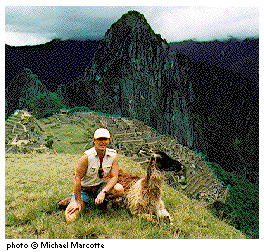
To convince my wife to come to Peru, I used the reasoning that I very much wanted to experience firsthand the jungle that was the setting for my pending novel. That was part of it, to be sure, but I have always wanted to climb around in those cloud-enshrouded Inca ruins atop Machu Picchu. We spent a couple of days doing that, en route, and neither of us was disappointed. To reach the Explorer's Inn, we had to return to Cuzco and fly into Puerto Maldonado. Now, here is a frontier town for you. You walk down a ramp from the plane and see a jungle that threatens to overgrow the landing strip at any opportunity. At the front door of the airport await a dozen horse- or bicycle-drawn rickshaws that serve as taxis. I was more than a bit disappointed that the Explorer's Inn had a van waiting for us, instead. From the airport we drove through town to the Explorer's Inn's office where we waited while our guide obtained the necessary signatures on our transit documentation. Only 200 or so travelers are allowed into the area each year, so it is necessary to plan well ahead of time. At this office in Puerto Maldonado, we also left a few bags that we wouldn't need in the jungle. Space is at a premium aboard the piroque/dugout canoes that transport visitors and local inhabitants up the river to the lodge. These craft are a little topsy-turvy, so it's really to your advantage not to weigh them down with unnecessary luggage. Remember, there are crocodiles. 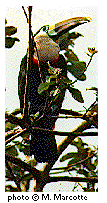
I had pre-arranged a stop at a more-or-less primitive Indian village along the way, but that did not materialize. I later learned that the Explorer's Inn hasn't done such visits for about ten years. Alas, I am STILL WAITING on a partial REFUND from TARA TOURS, of Miami, who otherwise did a very good job of booking everything I had requested in our custom package. The river voyage took about 3 1/2 hours. We made only one stop along the way, at a Guardia Civil outpost. A strong bladder is recommended, under such circumstances. It is also very important to stop at the Guardia Civil outpost. In a recent and much publicized case, an innocent Japanese tourist who failed to stop was shot dead by G.C. sentries who assumed he must be a drug smuggler. On arrival at the lodge, we were met by Sam, who stood barefooted next to the steps rising from the dock up thirty feet or more to the compound. We were shown to our bungalow to rest a bit before lunch. The bungalows are Spartan, but comfortable enough. The windows are screened to allow the flow of air while restricting insects. Mosquito netting covers each bed. In the afternoon, we donned the provided "Welties" for the first of several guided treks along trails that meander between 4 to 12 km through the jungle. As on all of these treks, Sam cautioned us to keep as quiet as possible, but whenever she wasn't pointing out blue Morpho butterflies, red huasai roots, various animal tracks and quinine, Brazil Nut or rubber trees, then someone was asking Sam a question. We hardly saw any wildlife on these walks. It was all still very educational and enjoyable, but you do have to like mud. 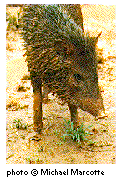
A pet peccary and two macaws enliven the compound between excursions, and there is plenty of time to get acquainted with the human visitors. Three naturalists, a camp manager, and about five cooks/other staff form the remaining population of the compound, in addition to the adventure tourists. There were only six of the latter when I was there, but the compound could handle about twenty. The best nature trek in the encircling wilderness is a leisurely march of about 4 1/2 miles to the Cocococha lagoon. Actually an oxbow lake, formed when a loop in the river was cutoff by a change in the river's course, this lagoon is home to a variety of wildlife. We saw a pair of rare hoatzin birds (the ones with a claw on their wing that scientists cite as support for the dinosaurs-evolved-from-birds theory) and went for a swim in the refreshingly cool water. 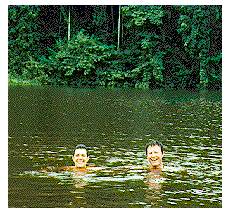
Of course, prior to dunking ourselves in the lake, we put our minds at ease concerning any dangers that might exist. Sam nonchalantly admitted that yes, there were 5 species of piranha in the lake, but only two were carnivorous. My wife and I entered the water only after patiently observing that a bolder German companion was not promptly devoured (maybe he failed to understand that Sam said "piranha"). Then, there is the candiru. This tiny 2 1/2 centimeter catfish is a parasite that, if able, invades and makes a home in one's urethra. The candiru expands several spines around its head, firmly and painfully entrenching itself and must be removed surgically. From the urethra. Ouch! It is the only known vertebrate that parasites man. Fortunately, the candiru only enters the urethra by detecting the flow of urine and following the stream to its source. There are only a couple of documented human cases. Nevertheless, it is strongly advisable to keep one's knickers on, and not to pee in the lake! 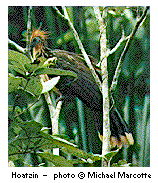
The final thrill was provided by the information from Sam, once we were all swimming at the center of the lake, that an eighteen-foot caiman (Amazon crocodile) nested in "those reeds over there...along the shore." Sam confessed that while others had seen this huge reptile, she never had. Caimans, she promised, are strictly nocturnal. It was February when I visited - part of the rainy season. Such terminology is all relative. It rains year round in the rain forest. Go figure. The only problem the rain presented was that it was difficult to seek out caiman, in the river, at night. And, of course, that is a highly attractive activity at the lodge. Because the Río Tambopata was rising so fast, the banks were well underwater, and the caiman were unable to wait there, as was customary, for their favorite evening meal of unsuspecting capybara, come for a drink. Sam used a spotlight to catch the reflection from the caiman's eyes, but we were only able to locate one small specimen. The river continued to rise through the night, and by the next day had washed away "Sunset Point" - an overhang that, the previous day, was 6 feet above water. I would have liked to have stayed several more days, but our visit to the Madre de Dios ended on our fourth morning. We boarded the motorized piroque and reluctantly headed back down the still rising river to Puerto Maldonado. From Puerto Maldonado we flew directly to Lima. In the airport, while awaiting our flight home, we learned of an electrical outage over a quarter of Peru, including Cuzco, caused by the flooding of the hydroelectric dam near Machu Picchu. Hundreds of local inhabitants were killed in the flooding, and the power outage and resulting turmoil lasted for several days, dominating the CNN and world newscasts for about a week. We had left the affected areas just four days earlier. People often speculate about the dangers involved in a trip like this one, wondering why anyone would accept such risks, just to see new places and experience new things. 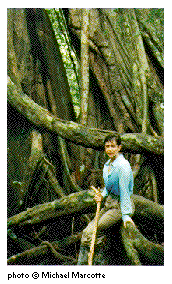
There is a Zen saying I once learned while studying the martial arts. The words are derived from instructions given to medieval samurai warriors: "Concentrate upon, and consecrate yourself wholly to each day, as if a fire rages in your hair." I don't pretend to have a good grasp on Zen wisdom, but I think what is meant is that to experience life fully we must be prepared to accept risks, to live each day intensely and without reserve - as if the next day, or even the next instant were your last. Failing to do so, life quickly becomes ritual - a routine taken for granted...and the short time we have here, fades, all too soon, into mere regrets of what once might have been, of the places we might have seen and of the things we might have done. Perhaps that explains why, every now and then - when we get the chance, some of us like to go for a walk in a jungle. Michael Marcotte's 376-page archaeological thriller, GOLD IN THE SHADOW, (ISBN 0-595-09414-7) is set in the Madre de Dios Rain Forest of Peru. The novel will be available from Writers Club Press at iUniverse.com, Amazon.com and most bookstores, beginning in June, 2000. Back to Michael's Magazine Articles Page |
 knee-deep mud oozes over the top of my rubber boots. It is the consistency of a Dairy Queen Blizzard and the color of... well, let's just say it isn't pretty.
knee-deep mud oozes over the top of my rubber boots. It is the consistency of a Dairy Queen Blizzard and the color of... well, let's just say it isn't pretty.